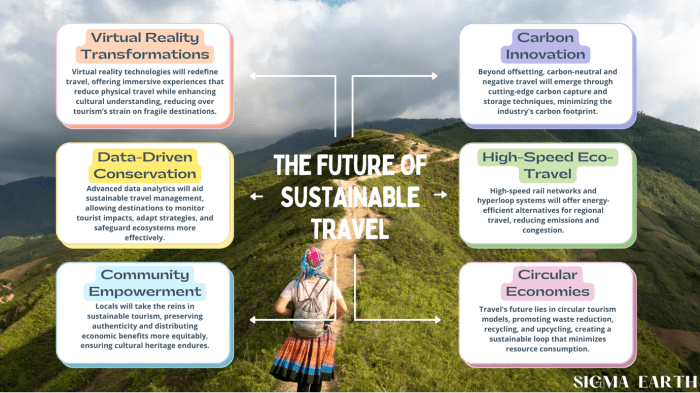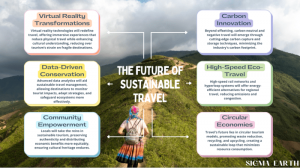
Sustainable travel and philanthropy: This compelling intersection explores how responsible tourism can directly benefit communities and the environment. We’ll examine various models, from volunteer tourism to donation-based travel, analyzing their effectiveness and impact. This exploration delves into practical strategies for minimizing your travel’s environmental footprint while maximizing positive social contributions, offering a framework for truly meaningful journeys.
Defining Sustainable Travel and Philanthropic Initiatives
Sustainable travel and philanthropic initiatives are increasingly intertwined, representing a powerful synergy for positive global impact. Sustainable travel focuses on minimizing the negative environmental and socio-cultural impacts of tourism while maximizing the positive benefits for local communities. Philanthropic initiatives, on the other hand, involve charitable giving or actions designed to improve the well-being of others. The intersection of these two areas creates opportunities for travelers to contribute directly to the betterment of the places they visit.The convergence of sustainable travel and philanthropic practices offers a unique opportunity to address global challenges while fostering meaningful travel experiences.
By aligning travel choices with ethical and responsible practices, individuals can contribute to environmental conservation, community development, and cultural preservation. This approach shifts the focus from simply consuming travel experiences to actively participating in creating positive change.
Examples of Organizations Combining Sustainable Tourism with Charitable Work
Many organizations effectively combine sustainable tourism with charitable work. For example, responsible travel companies often partner with local communities, ensuring that a significant portion of tourism revenue directly benefits local people and environmental projects. These partnerships might involve supporting local businesses, providing educational opportunities, or funding conservation efforts. Some organizations focus on specific causes, such as wildlife conservation or community health initiatives, integrating these into their tour offerings.
Others might utilize a percentage of their profits to fund charitable causes related to their destinations. These initiatives demonstrate the practical application of merging sustainable tourism and philanthropy.
Environmental and Social Impacts of Responsible Travel Initiatives
Responsible travel initiatives have significant positive environmental and social impacts. Environmentally, these initiatives reduce carbon emissions through promoting eco-friendly transportation, supporting sustainable accommodation, and minimizing waste generation. They also contribute to the conservation of natural resources and biodiversity by supporting protected areas and responsible wildlife tourism. Socially, responsible travel promotes fair wages and working conditions for local communities, supports local businesses and craftspeople, and fosters cultural understanding and respect.
It aims to avoid the negative impacts of mass tourism, such as over-exploitation of resources and cultural commodification. The reduction in negative impacts allows for a more balanced and beneficial relationship between tourists and host communities.
Case Studies of Successful Sustainable Travel Philanthropy Projects
Several successful projects demonstrate the effectiveness of combining sustainable travel and philanthropy. For instance, organizations supporting community-based ecotourism projects in developing countries have seen positive outcomes, such as improved infrastructure, increased income for local communities, and enhanced environmental protection. These projects often involve training locals in sustainable tourism practices, ensuring that the benefits are distributed equitably. Another successful example is the work of organizations supporting reforestation and conservation projects through traveler contributions.
By integrating these initiatives into their tour offerings, they are able to raise funds and awareness, directly contributing to environmental restoration and biodiversity protection. These case studies highlight the tangible positive impact of responsible travel philanthropy.
Types of Sustainable Travel Philanthropy

Sustainable travel philanthropy encompasses a diverse range of models designed to integrate charitable giving with travel experiences. These models offer travelers opportunities to contribute meaningfully to local communities while exploring new destinations, fostering a more responsible and impactful form of tourism. The key difference between models often lies in the level of direct involvement and the nature of the contribution.
Two prominent models are volunteer tourism and donation-based travel programs. While both aim to benefit local communities, they differ significantly in their approach to engagement and the type of support provided.
Volunteer Tourism
Volunteer tourism, also known as voluntourism, involves travelers directly participating in projects that benefit local communities. This might include working on environmental conservation initiatives, assisting with educational programs, or contributing to infrastructure development. The engagement is hands-on, providing a tangible contribution while offering travelers a unique cultural immersion experience.
The benefits of volunteer tourism are multifaceted. For travelers, it provides a deeply rewarding experience, fostering a stronger connection with the visited community and a deeper understanding of local challenges. For communities, it can offer much-needed human resources and skills, supplementing local efforts and accelerating project timelines. However, challenges exist. Potential pitfalls include poorly organized programs lacking clear objectives or proper training, leading to ineffective work or even unintentional harm to the community.
There’s also a risk of “voluntourism” overshadowing or undermining existing local initiatives, potentially creating dependency rather than empowerment.
Donation-Based Travel Programs
Donation-based travel programs operate differently. Travelers contribute financially to a specific cause or organization associated with their trip. This contribution might be a percentage of the tour cost, a separate donation, or a combination. The traveler’s involvement is primarily financial, though they may have opportunities to learn about the supported project and its impact.
The advantages of donation-based travel include accessibility and simplicity. It’s a less demanding model for travelers, requiring less time commitment and specialized skills. For organizations, it offers a reliable stream of funding to support ongoing projects. However, the lack of direct involvement can limit the traveler’s connection with the community and the perceived impact of their contribution. Transparency and accountability are critical to ensure that donations are effectively used and the impact is measurable.
Framework for Evaluating the Effectiveness of Sustainable Travel Philanthropy
Evaluating the effectiveness of sustainable travel philanthropy requires a multi-faceted approach. A robust framework should consider several key aspects:
A comprehensive evaluation should include:
- Project Impact: Measuring the tangible outcomes of the project supported (e.g., number of trees planted, students educated, improved infrastructure). This requires clear, measurable objectives set beforehand.
- Community Engagement: Assessing the level of involvement and ownership by the local community in the project’s design, implementation, and sustainability. Genuine community leadership and participation are crucial for long-term success.
- Environmental Sustainability: Evaluating the environmental impact of the travel and the project itself. This might include assessing carbon emissions, waste management, and resource consumption.
- Traveler Satisfaction and Learning: Gauging the travelers’ experience, their level of engagement, and their understanding of the project and its impact. This can be done through surveys and feedback mechanisms.
- Financial Transparency and Accountability: Ensuring that the financial resources are used effectively and transparently, with clear reporting on how donations are allocated and the impact achieved. Independent audits can enhance credibility.
By employing a comprehensive evaluation framework, stakeholders can ensure that sustainable travel philanthropy initiatives genuinely contribute to positive social and environmental outcomes, fostering a more responsible and impactful form of tourism.
Impact Measurement and Reporting in Sustainable Travel Philanthropy: Sustainable Travel And Philanthropy
Effective measurement and reporting are crucial for demonstrating the value and impact of sustainable travel philanthropy. Without robust data collection and analysis, it’s difficult to showcase the positive changes achieved and to attract further investment in similar initiatives. This section Artikels methods for tracking social and environmental impacts, structuring reports, and communicating results to key stakeholders.
Methods for Measuring Social and Environmental Impact
Measuring the impact of sustainable travel philanthropy requires a multi-faceted approach, combining quantitative and qualitative data. Quantitative data, such as the number of trees planted or the amount of carbon emissions reduced, provides concrete evidence of progress. Qualitative data, gathered through interviews, surveys, and focus groups, offers richer insights into the lived experiences of those who benefit from the initiatives.
For example, a project supporting eco-lodges in a remote community might track both the increase in local employment (quantitative) and the improvements in community well-being reported by residents (qualitative). This combined approach provides a more complete picture of the initiative’s success.
Reporting Structure for Sustainable Travel Initiatives
A clear and concise reporting structure is essential for effectively communicating the impact of sustainable travel initiatives. A standardized format, consistently applied across different projects, allows for easier comparison and benchmarking. A typical report might include an executive summary highlighting key findings, a detailed description of the initiative’s goals and activities, a presentation of quantitative and qualitative impact data, a discussion of challenges encountered and lessons learned, and a plan for future activities.
Visual aids, such as charts and graphs, can effectively communicate complex data to a wider audience. For instance, a bar chart could visually represent the increase in local income generated by a tourism project over several years.
Key Performance Indicators (KPIs) for Sustainable Travel Philanthropy
Selecting relevant KPIs is vital for tracking progress and demonstrating impact. These indicators should be aligned with the specific goals of the initiative and should be measurable, achievable, relevant, and time-bound (SMART). Examples of relevant KPIs include: the number of jobs created, the reduction in carbon emissions, the increase in local community income, the improvement in biodiversity, the number of tourists educated about sustainable practices, and the level of community satisfaction with the project.
Regular monitoring of these KPIs allows for timely adjustments to the initiative’s strategies and ensures that resources are used effectively. For example, tracking the number of tourists participating in responsible tourism activities can demonstrate the success of an educational campaign.
Communicating Impact to Stakeholders
Effective communication is essential for ensuring that the impact of sustainable travel philanthropy is understood and appreciated by all stakeholders. This includes donors, beneficiaries, government agencies, and the wider public. Reports should be tailored to the specific audience, using clear and concise language, avoiding technical jargon, and employing visual aids to enhance understanding. In addition to formal reports, other communication channels, such as social media, newsletters, and website updates, can be used to share stories and highlight successes.
Sharing compelling narratives of individual beneficiaries and showcasing the positive impact on local communities can help build support for future initiatives. For instance, a short video featuring a local entrepreneur whose business has thrived thanks to a sustainable tourism project can be a powerful communication tool.
Sustainable Travel Options and Their Philanthropic Potential

Sustainable travel offers a unique opportunity to minimize your environmental impact while contributing positively to the communities you visit. By choosing responsible travel options and supporting ethical businesses, travelers can align their wanderlust with philanthropic goals, creating a more meaningful and impactful travel experience. This section explores various sustainable travel choices and their potential for positive social and environmental change.
Flight Deals and Hacks
Finding affordable flights is key to making sustainable travel accessible. However, the environmental impact of air travel remains significant. Therefore, offsetting carbon emissions is crucial. The following table provides tips for finding cost-effective and environmentally responsible flight options:
| Airline | Tip | Savings Potential | Carbon Offset Options |
|---|---|---|---|
| Various | Book flights well in advance or during off-peak seasons. | Up to 50% | Use airline’s offset program or third-party providers like Atmosfair or Myclimate. |
| Budget Airlines | Consider budget airlines for shorter distances, but factor in baggage fees. | Variable, often significant | Most budget airlines now offer carbon offsetting options. |
| Loyalty Programs | Utilize airline loyalty programs to earn points for future flights or upgrades. | Variable, depending on program | Some programs offer partner benefits for carbon offsetting. |
| Flight Comparison Websites | Use comparison websites like Google Flights or Skyscanner to compare prices and routes. | Variable, depending on search | Many websites now integrate carbon offsetting options into their search results. |
Train Travel Guides
Train travel presents a significantly more sustainable alternative to air travel, reducing your carbon footprint while often offering a more scenic and relaxing journey. Planning a sustainable train journey involves considering route options, minimizing waste, and maximizing comfort.Planning a sustainable train journey requires careful consideration of routes and packing. Here are some route suggestions and packing tips:
Route Suggestions: Consider high-speed rail networks in Europe (e.g., Eurostar, Thalys), Amtrak in the USA, or Japan’s Shinkansen for efficient and scenic travel. For longer distances, plan for overnight trains to maximize travel time.
- Reusable water bottle
- Snacks and light meals to reduce reliance on train dining
- Comfortable clothing and layers
- Entertainment (books, e-reader, downloaded movies)
- Travel pillow and eye mask
- Noise-canceling headphones (optional)
Cruise Ship Reviews
The cruise industry has faced criticism for its environmental impact. However, some lines are actively working to improve their sustainability practices and engage in philanthropic initiatives. Here are some examples of cruise lines and their sustainability efforts. Note that this is not an exhaustive list, and sustainability practices are constantly evolving.
“Company A has invested in advanced waste management systems and is actively reducing its carbon emissions through fuel efficiency improvements and alternative fuel exploration.”
“Company B has a strong commitment to environmental conservation, partnering with organizations to protect marine ecosystems and support local communities. However, their waste management practices could be further improved.”
“Company C has made some progress in sustainability, but their efforts are less comprehensive compared to industry leaders. More transparent reporting of their environmental impact is needed.”
Road Trip Guides
Road trips offer a flexible and immersive way to explore a region, allowing for the discovery of hidden gems and a deeper connection with the environment and local cultures. This itinerary focuses on eco-friendly destinations and activities, minimizing environmental impact while maximizing cultural experiences.
Itinerary Example (adjust based on location and interests): Day 1: Visit a national park focusing on hiking and wildlife observation. Day 2: Explore a nearby town known for its sustainable tourism practices and local crafts. Day 3: Visit a farm-to-table restaurant and learn about sustainable agriculture. Day 4: Participate in a community-based conservation project. Day 5: Visit a museum or cultural center showcasing local history and traditions.
Budget Accommodation Tips
Affordable and eco-friendly accommodation options are plentiful for the budget-conscious traveler. Choosing sustainable lodging not only reduces your environmental impact but often supports local communities and businesses.
- Hostels: Offer affordable shared rooms and often promote sustainable practices.
- Eco-lodges: Feature sustainable design and often support local conservation efforts.
- Guesthouses and B&Bs: Provide a more intimate and personalized experience with a smaller environmental footprint than large hotels.
- Camping: A budget-friendly and low-impact option, ideal for nature lovers.
- Couchsurfing: A unique and free option, connecting travelers with locals who offer a place to stay.
Vacation Rentals and Airbnb
Vacation rentals, while offering flexibility and space, can have a significant environmental impact if not managed responsibly. However, by choosing eco-friendly options and adopting responsible practices, travelers can minimize their footprint.
Examples of eco-friendly vacation rentals: Look for properties with certifications like LEED or Green Globe, or those that highlight energy-efficient appliances, water conservation measures, and the use of renewable energy sources. Consider properties that utilize locally sourced materials and support local businesses.
Hotel Reviews and Tips
Many hotels are increasingly adopting sustainability certifications and practices. By choosing hotels with a demonstrated commitment to sustainability, travelers can support responsible tourism and reduce their environmental impact.
| Hotel | Water Conservation | Waste Reduction | Energy Efficiency |
|---|---|---|---|
| Example Hotel A | Low-flow showerheads, water-saving toilets | Recycling programs, reusable amenities | LED lighting, energy-efficient appliances |
| Example Hotel B | Water-efficient landscaping | Composting program | Solar panels |
| Example Hotel C | Smart water meters | Waste reduction targets | Smart thermostats |
RV and Camper Travel
RV and camper travel offer freedom and flexibility but can have a significant environmental impact if not managed responsibly. However, with careful planning and responsible practices, it’s possible to minimize the negative effects.
Minimizing the environmental impact of RV travel involves careful consideration of fuel consumption, waste disposal, and resource usage. Choosing campsites with sustainable practices, using energy-efficient appliances, and reducing water consumption are crucial steps. Furthermore, opting for biofuels or electric RVs can significantly reduce carbon emissions.
Unique Stays and Treehouses
Unique and sustainable lodging options, such as treehouses and eco-lodges, offer a unique and environmentally conscious travel experience. These accommodations often incorporate sustainable design features that minimize their environmental impact and support local communities.
Design features of eco-friendly accommodations: These can include the use of locally sourced and sustainable building materials, passive solar design for heating and cooling, rainwater harvesting, greywater recycling systems, and energy-efficient appliances. Eco-lodges often integrate seamlessly into their natural surroundings, minimizing disturbance to the ecosystem.
Houseboat and Yacht Stays
Houseboat and yacht stays offer a unique perspective but can have a considerable environmental impact due to fuel consumption and potential water pollution. Minimizing this impact requires responsible boating practices.
Responsible boating practices: This includes minimizing engine idling, using biodegradable cleaning products, properly disposing of waste, and respecting marine life and ecosystems. Choosing electric or hybrid boats can significantly reduce carbon emissions. Support operators committed to sustainability and responsible tourism.
Promoting Sustainable Travel Philanthropy
Promoting sustainable travel philanthropy requires a multifaceted approach encompassing strategic marketing, engaging social media campaigns, and compelling visual storytelling. Success hinges on effectively communicating the mutual benefits – both for travelers and the communities they visit – inherent in responsible tourism practices coupled with charitable giving. This involves showcasing the positive impact of such initiatives and motivating individuals and organizations to participate.A comprehensive marketing strategy should target diverse audiences, from eco-conscious individual travelers to corporate social responsibility departments.
It needs to highlight the unique selling proposition of sustainable travel philanthropy, emphasizing its positive environmental and social impact while also offering appealing travel experiences. Effective communication will be crucial in attracting and retaining participants.
Marketing Strategy for Sustainable Travel Philanthropy
The marketing strategy should leverage a multi-channel approach, combining digital marketing with traditional methods. This could include partnerships with travel agencies specializing in sustainable tourism, collaborations with non-profit organizations working in relevant areas, and the development of targeted advertising campaigns across various online platforms. Content marketing, featuring blog posts, articles, and videos showcasing successful projects, will also be vital in building trust and credibility.
Public relations efforts, focusing on securing media coverage in relevant publications and online platforms, will help reach a wider audience and establish the initiative’s reputation. Finally, a robust email marketing strategy, segmenting audiences based on interests and past engagement, will allow for personalized communication and targeted promotion of specific initiatives.
Social Media Campaign for Responsible Travel, Sustainable travel and philanthropy
A successful social media campaign requires a clear understanding of the target audience and the platforms they frequent. The campaign should utilize visually engaging content, including high-quality photos and videos showcasing the positive impact of sustainable travel philanthropy. The use of relevant hashtags will increase visibility and reach. User-generated content, encouraging travelers to share their experiences and photos, will foster a sense of community and authenticity.
Influencer marketing, partnering with travel bloggers and social media personalities known for their commitment to sustainable travel, can significantly boost awareness and reach a wider audience. Interactive elements, such as polls, quizzes, and contests, will enhance engagement and encourage participation. Consistent posting and timely responses to comments and messages are crucial for building a strong online presence and fostering a positive brand image.
Compelling Visuals for Sustainable Travel Philanthropy
Visuals are key to conveying the message effectively. One compelling image could depict a group of volunteers working alongside local community members on a sustainable tourism project, such as building an eco-lodge or restoring a historical site. The image should emphasize the collaborative nature of the work and the positive impact on both the environment and the local community.
Another impactful visual could be a before-and-after shot showcasing the transformation of a previously degraded environment thanks to a sustainable tourism initiative. This would highlight the tangible environmental benefits of the project. A third visual could be a short video showcasing the positive experiences of travelers participating in a sustainable travel philanthropy project, emphasizing the personal enrichment and cultural exchange aspects.
The video could include interviews with travelers and local community members, highlighting the mutual benefits of the initiative. Finally, infographics could visually represent the positive impact of the project, such as the number of jobs created, the amount of carbon emissions reduced, or the number of people helped. These infographics would use clear, concise language and compelling visuals to effectively communicate the project’s impact.
Ultimately, the convergence of sustainable travel and philanthropy offers a powerful pathway towards more responsible and rewarding travel experiences. By thoughtfully choosing our destinations, minimizing our environmental impact, and supporting local communities, we can transform tourism from a purely recreational pursuit into a force for positive global change. The journey itself becomes an act of giving back, leaving a legacy of environmental stewardship and social upliftment.
FAQ Corner
What are some examples of organizations that combine sustainable tourism with charitable work?
Many organizations exist! Examples include those focusing on wildlife conservation (supporting local anti-poaching efforts through tourism revenue), community development projects (building schools or providing healthcare access through tourism-generated funds), and environmental restoration (supporting reforestation or clean-up initiatives via traveler contributions).
How can I measure the impact of my sustainable travel choices?
Track your carbon footprint using online calculators. Consider the local economic impact of your spending (supporting local businesses versus large international chains). Document your volunteer work or donations to quantify your positive contributions. Review the sustainability certifications of your chosen accommodations and transportation.
Are there any tax benefits associated with philanthropic travel?
Tax benefits vary significantly by country and the specific nature of your donation or volunteer work. Consult a tax professional to determine if your philanthropic travel qualifies for any deductions or credits in your region.
How can I find truly sustainable tour operators?
Look for certifications like B Corp, Global Sustainable Tourism Council (GSTC), or similar accreditations. Research operators’ commitment to local communities and environmental protection; examine their transparency in disclosing their sustainability practices. Read independent reviews focusing on their environmental and social impact.





